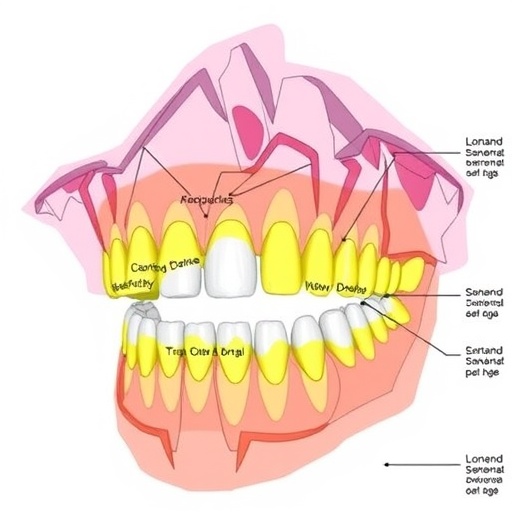
In the evolving landscape of forensic science and legal medicine, the accuracy of age estimation methods holds paramount importance, especially when applied across diverse populations. A groundbreaking study recently published in the International Journal of Legal Medicine addresses this critical issue by investigating the reliability of the London Atlas—a widely utilized dental age estimation tool—within an Australian cohort. The research, authored by Chua, Halim, Pham, and their colleagues, advances our understanding by meticulously evaluating the London Atlas’s applicability beyond its original demographic context. This inquiry is pivotal for forensic practitioners, anthropologists, and legal authorities who often confront the challenge of determining chronological age in individuals where birth documentation may be lacking or disputed.
Dental age estimation capitalizes on the progressive development and eruption of teeth as a biological marker for chronological age, particularly in children and adolescents. The London Atlas, developed by AlQahtani et al., represents a comprehensive visual charting system that offers reference images of dental development stages correlated with age. Its simplicity and non-invasive nature have made it a preferred tool globally. However, its initial validation predominantly involved UK populations, raising concerns about its precision when applied to ethnically and geographically distinct cohorts. The present study ventures into this gap by scrutinizing the atlas’s reliability within an Australian population characterized by unique genetic backgrounds and environmental influences on dental maturation.
Methodologically, the researchers assembled a robust sample of Australian individuals spanning crucial developmental age groups. The cohort included diverse ethnic backgrounds reflective of the population’s heterogeneity, thus providing a realistic testbed for the London Atlas’s versatility. Using orthopantomograms (panoramic dental X-rays), the investigators conducted staged assessments of tooth formation and eruption patterns as per the atlas guidelines. Statistical analyses then compared estimated dental ages against documented chronological ages, focusing on accuracy metrics, bias, and error margins.
.adsslot_rfRnEyHObv{width:728px !important;height:90px !important;}
@media(max-width:1199px){ .adsslot_rfRnEyHObv{width:468px !important;height:60px !important;}
}
@media(max-width:767px){ .adsslot_rfRnEyHObv{width:320px !important;height:50px !important;}
}
ADVERTISEMENT
Results revealed nuanced insights into the atlas’s performance. While the London Atlas demonstrated a generally strong correlation with chronological age in the Australian cohort, variations in precision surfaced when stratifying by age groups and ethnic subpopulations. Specifically, younger children exhibited more consistent age estimations than older adolescents, possibly reflecting accelerated or delayed dental maturation patterns influenced by genetic and environmental factors unique to Australia. Certain ethnic groups presented slight deviations, hinting at the necessity for population-specific adjustments or calibration within the atlas framework.
The study’s findings bear immense practical implications. Forensic odontologists often operate in settings where precise age estimation informs legal outcomes, such as asylum claims, age disputes in criminal justice, or identification of unknown remains. The demonstrated overall reliability of the London Atlas supports its continued use in Australia, albeit with cautionary acknowledgment of its limitations. This underscores the imperative for forensic protocols to incorporate population-tailored validation studies before universal adoption of age estimation methods.
Notably, the research team emphasizes the importance of ongoing data collection and atlas refinement to encapsulate variabilities inherent in contemporary populations. The global movement of people and increasing ethnic admixture challenge the notion of “one-size-fits-all” forensic tools. For instance, nutritional disparities, health conditions, and environmental exposures known to influence dental development must be integrated into future iterations of such atlases to enhance their predictive accuracy and forensic utility.
This exploration also reinforces the broader scientific consensus advocating for multi-faceted age estimation approaches. Combining dental assessments with skeletal analysis, biochemical markers, and advanced imaging techniques may yield higher accuracy and reliability. Enhanced computational modeling powered by machine learning could further tailor age predictions, accounting for complex biological and demographic variables identified through empirical research such as that of Chua and colleagues.
Moreover, the study exemplifies the collaborative synergy between clinical dentistry and forensic science. Bridging these disciplines promises innovations that transcend traditional boundaries, improving not only medicolegal outcomes but also public health surveillance and pediatric developmental research. Accurate age estimation has ramifications for early intervention strategies, growth monitoring, and epidemiological investigations pertaining to children’s well-being.
Intriguingly, the graphical representation encapsulated in the publication—likely depicting comparative scatter plots and Bland-Altman analyses—provides visual confirmation of the quantitative findings. Such rigor in methodological transparency enhances the reproducibility and credibility of forensic methodologies, inviting further scrutiny and validation by the global scientific community.
One must also consider ethical dimensions underlying this research. Age estimation techniques, while scientifically valuable, carry profound consequences when used in legal adjudications or immigration processes. Misestimations could result in unjust treatment or denial of rights. Consequently, the demonstrated reliability and identified limitations of the London Atlas in Australia inform not only scientific practice but also policy formulation, advocating for safeguards and confirmatory approaches in age diagnostics.
The study’s publication is timely, coinciding with rapid advancements in forensic technology and increasing demands for cross-jurisdictional standardization of age estimation protocols. It contributes empirical data that can catalyze updates in international guidelines, fostering harmonization while respecting population-specific nuances. Such evidence-based progress is crucial as forensic age estimation continues to underpin justice systems worldwide.
In a broader context, this research exemplifies how localized validation of forensic tools is indispensable in an era of globalization. Universal standards must be buttressed by robust data reflecting regional genetic and environmental landscapes to ensure equitable, precise applications. The London Atlas’s demonstrated strengths and caveats within an Australian cohort may thus inspire analogous studies in other parts of the world, from Asia to Africa, enriching the global forensic repository.
The study also prompts reflection on the potential integration of emerging biomarkers and genetic indicators into traditional dental age estimation. Future investigations might explore correlations between gene expression related to dental growth and radiographic maturation stages, potentially revolutionizing the field with personalized age diagnostics. Such interdisciplinary efforts may eventually supplant or augment atlas-based methods, offering unprecedented resolution and accuracy.
In conclusion, the work of Chua et al. represents a significant stride in forensic odontology and legal medicine, affirming the utility of the London Atlas while advocating for cautious, context-aware application. Their meticulous approach attests to the principle that forensic science must continually adapt and refine its methodologies to the ever-changing tapestry of human diversity. The study stands as both a validation and a call-to-action, urging the scientific and legal communities to embed population-specific evidence in the bedrock of age estimation practice, thereby enhancing justice and scientific integrity alike.
Subject of Research: Reliability of the London Atlas for dental age estimation in an ethnically diverse Australian cohort.
Article Title: Reliability of London atlas for dental age estimation in an Australian cohort.
Article References:
Chua, A., Halim, C., Pham, E. et al. Reliability of London atlas for dental age estimation in an Australian cohort. Int J Legal Med (2025). https://doi.org/10.1007/s00414-025-03559-2
Image Credits: AI Generated
DOI: 10.1007/s00414-025-03559-2
Keywords: Dental age estimation, London Atlas, forensic odontology, age estimation reliability, Australian cohort, dental development, forensic medicine
Tags: age estimation methods in diverse populationsanthropological studies on dental growthchallenges in forensic age determinationcross-cultural applicability of dental toolsdental development stages in childrenforensic science in Australiaimportance of accurate age estimation in legal contextslegal medicine and dental analysisLondon Atlas dental age estimationnon-invasive age estimation techniquesreliability of dental age assessmentUK vs Australian dental research





